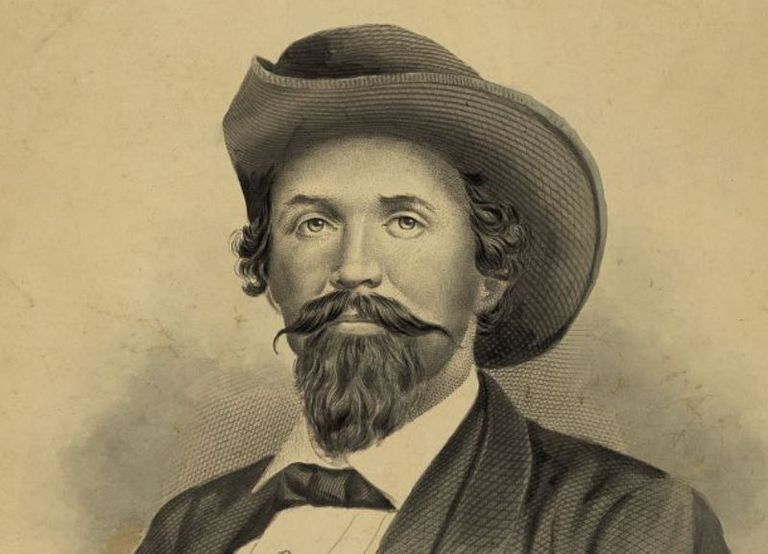Who is John Morgan?
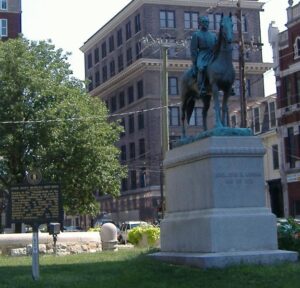
John Hunt Morgan was born on June 1, 1864 in Huntsville, Alabama. He was the eldest of ten children born to Calvin and Henrietta (Hunt) Morgan.
When Calvin Morgan’s pharmacy failed, he moved his family to Lexington, Kentucky. There John grew up on a farm and attended Transylvania College for two years. He was suspended from classes in 1884 for dueling with a fraternity brother.
In 1846, Morgan became a Freemason and member of the Daviess Lodge #22 in Lexington. At that time, the US military was very small, and so a military career was limited on the officer’s commission. However, Morgan would end up joining the military.
Mexican-American War
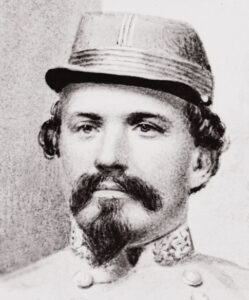
With his brother Calvin and uncle Alexander, John enlisted into the US Army in 1846. He would enlist as a cavalry private. Before he arrived in Mexico, Morgan would be elected to second lieutenant and then promoted to first lieutenant. He would see combat at the Battle of Buena Vista in February 1847.
After the War
Upon returning to Kentucky, Morgan became a hemp manufacturer. He also married the sister of his business partner, 18 year-old Rebecca Gratz Bruce.
His fortunes began to greatly improve when his mother, Henrietta, began to finance his business ventures after the death of John Wesley Hunt in 1849. John Wesley was John Hunt Morgans paternal grandfather and the founder of Lexington, Kentucky.
Tragedy and Scandal
Morgan’s wife Rebecca gave birth to a stillborn son in 1853. She had contracted “milk leg” thrombophlebitis which is caused from an infection of a blood clot in a vein. This led to Rebecca losing her leg over he infection.

Known as a scoundrel, Morgan had a reputation as a gambler, a womanizer and being generous with his money. It is widely known that Morgan fathered a slave son with an unnamed slave woman named Sidney who later became the biological grandfather to African American inventor Garrett Morgan. Garrett would be the inventor of the gas masks.
Lexington Rifles
He wanted a military career and so he formed his own militia artillery company in 1852. This militia was disbanded just two years later by the Kentucky State Legislature. Not one to give up, Morgan then raised an independent infantry company called the “Lexington Rifles”. He would often spend his free time drilling and being with his men.
The Election of Abraham Lincoln
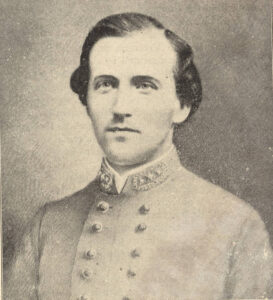
Most Kentuckians did not support secession and Morgan was counted among them initially. After the election of Abraham Lincoln in November of 1860, Morgan wrote to his brother Thomas who was attending Kenyon College in Northern Ohio. In his letter he states that he thinks that Lincoln will be a good President in his opinion but he would wait to see what happens.
Thomas Morgan then transferred his college to the Kentucky Military Institute in the Spring of 1861 in case the state of Kentucky would need his services. By the Fourth of July of that year, Thomas would leave the Institute and join the Kentucky State Guard. John would remain in Lexington to tend to his business and his sick wife Rebecca until her death on July 21, 1861.
Joining the Confederacy
In September of 1861, Morgan and his militia company traveled to Tennessee where they joined the Confederate States Army. Morgan joined as a scout and by early of 1862 he held the rank of captain.
He also raised the 2nd Kentucky Cavalry Regiment and was promoted to the rank of colonel on April 4, 1862.
The Battle of Shiloh
During the Battle of Shiloh on April 6th through the 7th of 1862, Morgan and his cavalrymen fought with General Albert Sidney Johnston and his troops to face off against Generals Grant and Garfield. It was hoped that due to his bravery at this battle that Kentucky would leave the union states and join the Confederacy. This did not happen as Kentucky remained neutral during the entire Civil War.
Morgan’s First Raids
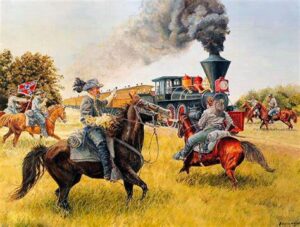
With 900 men on July 4, 1862, Morgan led raids for three weeks throughout the state of Kentucky. One of his most interesting was the Major General Don Carlos Buell’s army. He would follow deep behind them and pick them off from behind as they advanced. It is reported that he captured 1,200 soldiers, whom he paroled, several hundred horses, and destroyed a massive amounts of supplies. These actions were so successful that it unnerved Kentucky’s military government and they sent many letters requesting help as they were being over ran in Kentucky.
Morgan’s Second Raids
In December of 1862 through January of 1863, Morgan would then do the same thing to Union Major General William S. Rosecrans army. He would have a victory at the Battle of Hartsville on December 7th of 1862.
Second Marriage
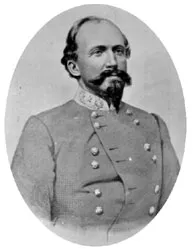
Engraving by George Edward Perine (1837–85)
During this time while he was carrying out his raids against Rosecrans, Morgan found time to get married. Martha “Mattie” Ready became Morgan’s bride on December 14, 1862 the same day he officially became a brigadier general. She was the daughter of Tennessee United States Representative Charles Ready and a cousin to another Tennessee United States Representative William T. Haskell.
Brigadier General
Morgan was then promoted to brigadier general in command of the Regiment on December 11, 1862. President Davis would sign the promotion on December 14. On May 1, 1863, he would receive a thanks from the Confederate Congress.
Morgan’s Raids into Ohio and Indiana
This would be the farthest North that the Confederacy would ever reach during the entire time of the Civil War. Morgan took 2,462 cavalry and a battery of light artillery of his men against the orders of General Bragg across the Ohio and Indiana state lines. Bragg had strictly forbade Morgan and his men to cross the Ohio River for concern that he might become to aggressive.
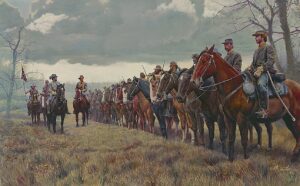
In early July of 1863, Morgan and his men captured two steamboats at Brandenburg, Kentucky which they used to transport troops across the Ohio River. They would land near Maukport, Indiana with the men and this caused panic among the local residents of the area.
There he was able to have several skirmishes. Several of which include the Corydon, Indiana and Versailles, Indiana which he captured and paroled several thousands of union soldiers.
His raids captured the public imaginations as the Morgan’s Raiders began to gain more fame during this time. Although now it is seen as nothing more than a very showy and futile sideline of the war itself, and seen as a direct violation to his commanding officer’s orders.
Major General Ambrose Burnside, the commander of the Department of the Ohio was alerted to the presence of Morgan and began to shift his troops around to confront and capture Morgan. On July 19, 1863, Morgan’s raids were almost ended when trying to cross from Ohio into West Virginia, at Buffington Island, Ohio. Seven hundred of Morgan’s men were captured and sent to the deadly Camp Douglas Prisoner of War camp in Chicago. On July 26th, near Salineville, Ohio, Morgan and his 300 remaining men surrendered and was taken to prison.
Escape
On November 27, 1863, Morgan and six of his officers escaped from their cells from the Ohio Penitentiary by digging tunnels to the inner yard then scaling the wall. They then boarded at train near Columbus train station and arrived in Cincinnati, Ohio that morning. They jumped off of the train before arriving at the depot and hired a skiff to cross the Ohio River.
Return and Reinforcements
After his return, Morgan was then given reinforcements to his raiding party. These men were not as disciplined as the other men and caused a lot of problems following orders. Also, his former raiding days had caused outrage and thus the Union soldiers were now aware of and prepared for raiders.
The Last Raid and Pound Gap
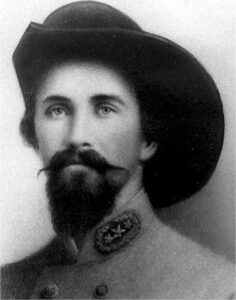
On June 1, 1864, John Hunt Morgan would lead his men against a small Union detachment from Pound Gap. They would use the Pound Gap as a way to gain access to Central Kentucky and then again as an escape route. Morgan and his Raiders would humiliate the Union soldiers that had set up camp at the base of Pine Mountain as the went through the area to Cynthiana, Kentucky.
Against an inferior force, Morgan won a minor battle on June 10, 1864 at the Battle of Keller’s Bridge on the Licking River, near Cynthiana, Kentucky.
Known as the Second Battle of Cynthiana, on June 11, 1864, Morgan led his troops into battle once more. Feeling confident from his victory the day before, Morgan confronted a much superior Union mounted forces than the day before. This led to disaster as Morgan’s forces and cohesive unit were decimated. Only a few escaped with their lives including Morgan and a few of his officers.
Trans-Allegheny Department
Although Bragg no longer trusted Morgan to obey his orders. On August 22, 1864, Morgan was placed in command of the Trans-Allegheny Department. This was to pull together all of the forces of eastern Tennessee and Southwestern Virginia.
Bank Robbery and Death
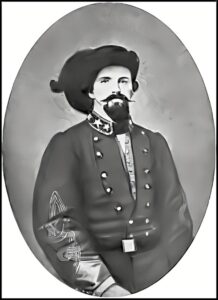
During the summer of 1864, a bank in Mt. Sterling Kentucky was robbed. Morgan was accused of masterminding the robbery. While it is suspected that some of his men might have been involved, it is now thought that Morgan had nothing to do with the event. However, he was charged with criminal banditry and removed from his command.
While working to clear his name from the bank robbery, Morgan and his men were encamped near Greenville, Tennessee. On the morning of September 4, 1864, Union troops attacked. While trying to retreat his men from the area, Morgan was shot in the back by a union cavalryman. Morgan died from this injury. His body is buried in Lexington, Kentucky.
Thank You
Thank you for reading our article about General John Hunt Morgan and his Raiders. We thank you for continuing to support Kentucky Tennessee Living. As we bring to you the history of the Appalachian Mountains.
Sources
Pound Gap Civil War Memorial
http://kytnliving.com/poundgapcivilwarmemorial
The Battle of Pound Gap
March 16, 1862
Facebook Post March 16, 2016 Kentucky Tennessee Living
Pound Gap ~~ there is more than meets the eye.
February 10, 2021
Facebook Post Kentucky Tennessee Living
John Hunt Morgan
https://www.findagrave.com/memorial/4433/john-hunt-morgan
John Hunt Morgan
Confederate general
https://www.britannica.com/biography/John-Hunt-Morgan
John Hunt Morgan
https://www.battlefields.org/learn/biographies/john-hunt-morgan
American Civil War: Brigadier General John Hunt Morgan
https://www.thoughtco.com/brigadier-general-john-hunt-morgan-2360170
Brig. General John Hunt Morgan (CSA)
https://www.geni.com/people/Brig-General-John-Hunt-Morgan-CSA/6000000011154199199
John Hunt Morgan
https://en.wikipedia.org/wiki/John_Hunt_Morgan
Copyright and Other Information
All photos are in the public domain unless otherwise noted. This includes photos dated before 1923. All other photos are used with permission or under the education fair use statute of the US copyright law.
Copyright 2022 Kentucky Tennessee Living
Social Media Pages
For more about us, you can visit our Facebook page:
https://www.facebook.com/kytnliving
Our Twitter page:
https://www.twitter.com/KYTNLiving
Our YouTube Channel:
https://www.youtube.com/kytnliving
When we forget our past and who we are as a people, then we become who “they” say we are. ~~ David Sergent
I have attended the University of Kentucky. I have an Associates Degree from Hazard Community College and Technical School. I have also attended the University of Pikeville. I have taken several classes in Journalism as well as in the Appalachian History, Literature, and Sociology during my time at those schools.
I was born in Florida and grew up in Burdine, Kentucky. I have been married to David W. Sergent since May 4, 2013. I have two children and four grandchildren from a previous marriage. I currently live in Tennessee but my hope is to one day come back home to live in the beautiful mountains once more.


